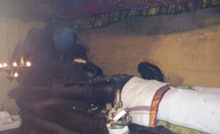

Tirunelveli is one of the many temple towns in the state which is named after the groves, clusters or forests dominated by a particular variety of a tree or shrub and the same variety of tree or shrub sheltering the presiding deity. The region is believed to have been covered with Venu forest and hence called Venuvanam.[1]
The original complex is believed to have been built by Pandyas, while the present masonry structure was added by Cholas, Pallavas, Cheras, and Madurai Nayaks. The sanctums of the temple and the gopurams were constructed by Nindraseer Nedumaran (Koon Pandian) who reigned in the 7th century AD. The mani mandapam with its famous musical pillar was also likely built by Nindraseer Nedumaran. The flag stand near the Nandi was set up in 1155.[2] Later Pandya, Kulasekara Pandyan I built the outer wall of the Thirunelveli Nellaiappar temple, in 13th century.
Originally, the Nellaiappar and Kanthimathi temples were two independent structures with spaces in between. It was in 1647 that Thiru Vadamalaiappa Pillaiyan, a great devotee of Siva linked the two temples by building the "Chain mandapam" (In Tamil Sangili Mandapam). In the centre of the Flower Garden is a square vasantha mandapam with 100 pillars. The Nandi mandapam is said to have been built by Sivanthiappa Nayakar in 1654. To the western portion of the chain mandapam is the flower garden that was set up in 1756 by Thiruvengadakrishna Mudaliar.[3]
There are a number of stone inscriptions in the temple. The most important of them are those Veerapandiyan who reigned around 950 AD and those of Rajendran I and Kulothunga Chola I. The inscriptions of Maravarman Sundara Pandyan refer to the Lord as "Woodayar" and "Wodeyanayanar" and the Goddess as "Nachiar". From the inscriptions of Kulasekkara Pandiyan we learn that he defeated the Chera, Chola and Hoysala kings and built the outer walls of the temple with the spoils of war.[4]